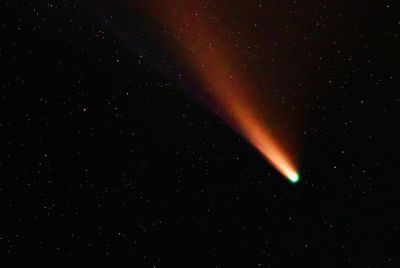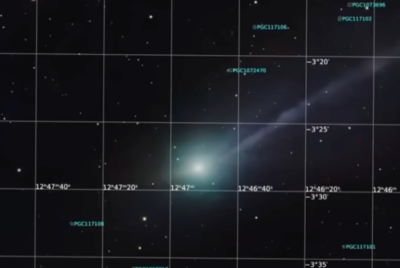3I/ATLAS Comet Or Spaceship? Scientists Point Out Anomalies That Show Interstellar Object Might Have Alien Tech
Avi Loeb views the planetary alignments as 'planned', evoking spaceship theories over comet labels

In the vast expanse of space, the interstellar object 3I/ATLAS races towards our solar system, sparking fierce debate among astronomers on 1 July 2025 when the ATLAS telescope first spotted it.
This third confirmed visitor from beyond our stars, following 'Oumuamua and Borisov, exhibits anomalies that challenge conventional comet models, with Harvard astrophysicist Avi Loeb assigning a 30-40 per cent chance it harbours alien tech.
As NASA and ESA missions track its hyperbolic path towards perihelion on 29 October 2025, the world ponders if this is a natural icy wanderer or an engineered spaceship probing Earth.
Discovery and Unusual Trajectory
Astronomers detected 3I/ATLAS on 1 July 2025 in Río Hurtado, Chile, confirming its extrasolar origin through a hyperbolic orbit with a velocity of approximately 152,000 mph at perihelion, 1.36 AU from the Sun. Unlike typical long-period comets, its path aligns improbably with flybys of Venus, Mars on 3 October 2025, and Jupiter, defying random odds of 0.005 per cent.
ESA's Mars Express and ExoMars observed it passing 30 million km from the Red Planet, capturing data on its coma but noting no immediate threat to Earth. NASA's Hubble imaged it on 21 July 2025 at 277 million miles from Earth, estimating a Manhattan-sized nucleus spanning 1.4 to 5.6 km and weighing 33 billion tons.
Avi Loeb, in a NewsNation interview, warned this scale and precision suggest 'alien origin', echoing his 'Oumuamua theories.
Comet 3I/ATLAS is much bigger than previously thought, weighing a record 33 billion tons and measuring at least 3 miles across, according to theoretical physicist Avi Loeb. He's warned it could be of "alien origin." MORE: https://t.co/ggtADxqzxi pic.twitter.com/DSZikL6Yzq
— NewsNation (@NewsNation) October 1, 2025
Such trajectory quirks fuel speculation, as JAXA researchers note its carbon dioxide-rich coma differs from solar system norms, prompting calls for deeper spectral analysis.
“Interstellar object 3I/ATLAS is being called a “comet” due to its coma, but its rich carbon dioxide composition appears to differ from that of comets in our Solar System.”— Shimaki Yuri, ISAS Program Office (full quote in image) pic.twitter.com/Z2m42VY78R
— JAXA Institute of Space and Astronautical Science (@ISAS_JAXA_EN) September 25, 2025
This rare visitor offers a window into distant star systems, yet its engineered-like route raises extraterrestrial questions.
Anomalous Composition and Activity
Swift telescope observations in July and August 2025 revealed 3I/ATLAS leaking water 'like a fire hose' at 2.9 times the Sun's distance, far exceeding expected sublimation rates for its size. NASA's James Webb Space Telescope detected a 7.6:1 CO₂-to-water ratio on 6 August 2025, 4.5 sigma above typical comets, while ESO's Very Large Telescope confirmed a puzzling nickel dominance over iron in September 2025—termed 'extremely puzzling'.
Hubble's polarisation readings showed unprecedented negative values, unseen in any solar system body, while low diatomic carbon despite high CO2 marked another spectral oddity. Non-gravitational acceleration below 4.6 m per day contradicts heavy outgassing, as jets produce no thrust on the nucleus. The Planetary Society highlights its dust activity starting at 6.5 AU, too distant for water ice alone, suggesting exotic mechanisms.
Avi Loeb lists these seven anomalies—size mismatch, weird composition, unexplained jets, odd polarisation, suspicious timing—as evidence against a fully natural interstellar object. Kinematic models estimate its age at 3–11 billion years—spanning and often predating our Sun—fueling the alien tech debate, countered by astrogeological arguments for natural origins and calls for further data.
Debate on Extraterrestrial Origins
Avi Loeb's September 2025 proposal of an artificial nuclear probe origin, backed by a Bayes factor of 10^28 favouring engineered design, has galvanised discussions. Its path mirrors the 1977 WOW signal from Sagittarius, adding intrigue to potential communication attempts.
NASA's Perseverance rover captured a cylindrical streak on 4 October 2025 near Mars, dismissed as an artefact, while Tianwen-1, Mars Express, and Hope probes withheld images despite protocols. ESA and CNSA cited delays, but experts like those at ORF Mumbai question if 3I/ATLAS resembles 'Oumuamua's non-cometary acceleration. The Guardian reports Loeb views the planetary alignments as 'planned', evoking spaceship theories over comet labels.
As it nears Earth in December 2025, public fascination grows, with ABC News noting its 33 billion-ton mass could release 'mini-probes' appearing as UAPs. Yet NASA reassures no collision risk, focusing on scientific gains from this interstellar object.
Comet 3I/ATLAS doesn't pose a threat to Earth, but it does provide NASA scientists and spacecraft with a rare opportunity to study an interstellar comet as it passes through our solar system. ☄ https://t.co/B1MkBRZuT4 pic.twitter.com/wAmBUEte8l
— NASA Solar System (@NASASolarSystem) September 30, 2025
Balancing anomalies with evidence, scientists urge vigilance, realising this could redefine our cosmic neighbourhood.
© Copyright IBTimes 2025. All rights reserved.





















